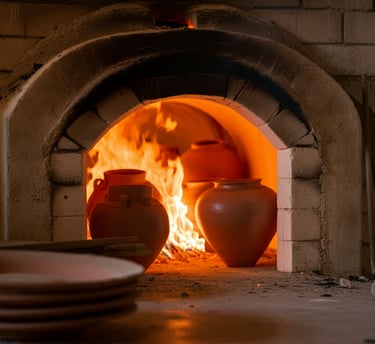Moroccan Pottery Firing: Process and Cultural Value
CRAFTSMANSHIP & TECHNIQUES
The firing of Moroccan pottery is a crucial step in the ancient process that converts raw clay into durable, visually pleasing, and utilitarian items. Moroccan history and cultural heritage profoundly embed this process, transcending its mere technicality. The fire process imparts strength, beauty, and usefulness to products, ranging from little ornamental pottery to substantial practical jars. This article will examine the rationale for firing Moroccan pottery, the significance of the firing process, and its impact on the finished product's quality, aesthetics, and longevity. We will also examine how this ancient technique has developed while preserving its basic foundations.
Enhancing pottery for everyday utilization
The main purpose for burning pottery is to enhance its strength for practical use. Moroccan artists start the handcrafting of pottery with raw clay, characterized by its softness, malleability, and fragility. We refer to this stage of pottery production as the "greenware" stage, where improper handling can cause the clay to break or crumble. To ensure the pottery is sufficiently robust for practical use, it must undergo a fire procedure that solidifies the clay.
Sintering, a chemical transition during burning, unites the clay particles at high temperatures, often exceeding 1000 °C (1832 °F). This transforms the pliable clay into a durable, rigid substance that is robust and capable of enduring daily use. Moroccan pottery often serves practical purposes, such as storing food, water, and cooking materials, making the hardening process crucial. The fire process guarantees that these clay products can withstand the rigors of everyday use, ensuring their durability.
Improved durability and water resistance
Firing not only hardens the clay but also significantly enhances the pottery's resistance to water and moisture. Unfired natural clay is incredibly porous, allowing it to absorb water and other liquids. If a ceramic object retains its porous condition, it is unsuitable for containing liquids or food because it rapidly absorbs moisture and may deteriorate over time.
Nevertheless, during firing, the pottery's porosity is markedly reduced. The elevated temperatures induce the fusion of clay particles, resulting in a denser and less porous surface. The decrease in porosity makes the pottery less absorbent, enabling it to retain liquids without leakage or degradation. Moroccan artisans meticulously craft numerous ceramic pieces, such as jugs, bowls, and cups, to contain or dispense liquids, but these pieces would not function efficiently without fire.
The substantial earthenware water jugs commonly found in Moroccan homes rely on the fire process to ensure their ability to retain water without leakage. These jugs, often adorned with traditional motifs, serve to maintain the coolness of water in the heated Moroccan environment. Furthermore, the fire procedure fortifies these vessels, ensuring that they remain intact under the strain of regular use.
Improving Aesthetic Appeal
The firing procedure not only fortifies Moroccan pottery but also elevates its aesthetic attributes. Vibrant hues, elaborate designs, and fine glazes distinguish Moroccan pottery. The shaping process incorporates numerous ornamental motifs into the pottery, but their full aesthetic potential only becomes apparent after firing.
Prior to burning, the applied glazes and hues seem lackluster and subdued. Upon exposure to the kiln's tremendous heat, a chemical reaction transpires in the glazes, resulting in vitrification, which imparts a glassy quality while enhancing the vibrancy and saturation of the colors. This shift is especially significant for Moroccan pottery, renowned for its vibrant color palette, with deep blues, vivid reds, and earthy yellows.
Moroccan artists sometimes use several glazing processes to produce beautiful designs on their ceramics. Zellige is a renowned type of Moroccan pottery distinguished by its geometric designs and vibrant hues. The fire process is crucial for attaining the shiny, smooth surface that distinguishes these pieces. In the absence of fire, the patterns and colors would seem muted, and the pottery would lack the stunning visual effect it has post-firing.
Conserving cultural heritage and traditions
The firing of Moroccan pottery has been a custom for centuries and remains a significant aspect of the country's cultural heritage. Morocco has been using pottery-making techniques for millennia, with archaeological evidence indicating manufacturing from prehistoric eras. The fire process is essential to this tradition because it not only converts the clay into a useful product, but it also safeguards the workmanship and creativity of Moroccan artists.
Wood or other natural combustibles typically fuel the construction of traditional Moroccan kilns, known as fours, from clay or stone. These kilns can reach high temperatures, allowing the pottery to be fired properly while maintaining its
Traditional kilns are a significant aspect of Moroccan pottery's cultural character. The act of igniting pottery in these kilns links craftsmen to their forebears, who used similar processes to produce pottery centuries before. The continuance of tradition serves as a source of pride for several Moroccan potters, who see their craft as a means of safeguarding their cultural legacy.
Reconciling tradition with modern technology
Although some Moroccan craftsmen continue to use conventional kilns and methods, a subset has started to integrate contemporary technologies into the fire process. Contemporary kilns, fueled by electricity or gas, provide enhanced control of the fire procedure. These kilns enable craftspeople to control the temperature with more precision, resulting in more uniform outcomes for the pottery's durability and aesthetics.
Contemporary kilns can mitigate the risk of over- or under-firing, which may compromise the pottery's integrity or result in uneven glaze application. By integrating modern technology into the fire process, some Moroccan potters may create pottery that adheres to current quality requirements while preserving the traditional workmanship and beauty that distinguish Moroccan pottery.
This balance between tradition and innovation enables Moroccan potters to sustain their art in a manner that honors their past while simultaneously ensuring the longevity and quality of their goods in a worldwide marketplace.
Ecological Consequences and Sustainability
The burning of pottery, like many conventional manufacturing methods, may have environmental repercussions. Moroccan artists traditionally use kilns that rely heavily on wood or other natural fuels, which could lead to deforestation and air pollution if not managed properly. Recently, Moroccan potters have increasingly recognized the need to enhance the fire process's sustainability.
Numerous craftsmen are currently investigating alternative fuels and more sustainable fire methods. For instance, some have been using kilns fueled by alternative energy sources, like solar energy or biomass. Others are exploring solutions to minimize fuel use in pottery firing by enhancing kiln insulation or using more efficient firing techniques.
By using these sustainable principles, Moroccan potters can produce exquisite, high-quality pottery while reducing the environmental effect of their art.
Final Assessment
The firing of Moroccan pottery is an essential phase in the manufacturing process that converts raw clay into resilient, practical, and visually appealing items. The firing process is crucial for Moroccan pottery's strength, water resistance, vivid colors, and detailed designs. Furthermore, the practice of burning pottery links Moroccan artists to their cultural history, enabling them to maintain ancient traditions while incorporating contemporary advances. Moroccan potters are preserving their art for future generations by combining heritage and sustainability.


